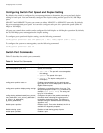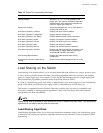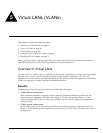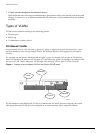
64 Summit 300-48 Switch Software User Guide
Virtual LANs (VLANs)
• VLANs ease the change and movement of devices.
With traditional networks, network administrators spend much of their time dealing with moves and
changes. If users move to a different subnetwork, the addresses of each endstation must be updated
manually.
Types of VLANs
VLANs can be created according to the following criteria:
• Physical port
• 802.1Q tag
• A combination of these criteria
Port-Based VLANs
In a port-based VLAN, a VLAN name is given to a group of one or more ports on the switch. A port
can be a member of only one port-based VLAN. The Summit 300-48 switch supports L2 port-based
VLANs.
For example, on the Summit 300-48 switch in Figure 1, ports 1:1 through 1:12 are part of VLAN Sales;
ports 1:13 through 1:24, and port 1:51 are part of VLAN Marketing; ports 1:25 through 1:36, and port 1:50
are part of VLAN Finance, and ports 1:37 through 1:48, and port 1:52 are part of VLAN Corporate.
Figure 1: Example of a port-based VLAN on the Summit 300-48 switch
For the members of the different IP VLANs to communicate, the traffic must be routed by the switch.
This means that each VLAN must be configured as a router interface with a unique IP address.
Sales
Marketing
Finance
Corporate
LB48005


















